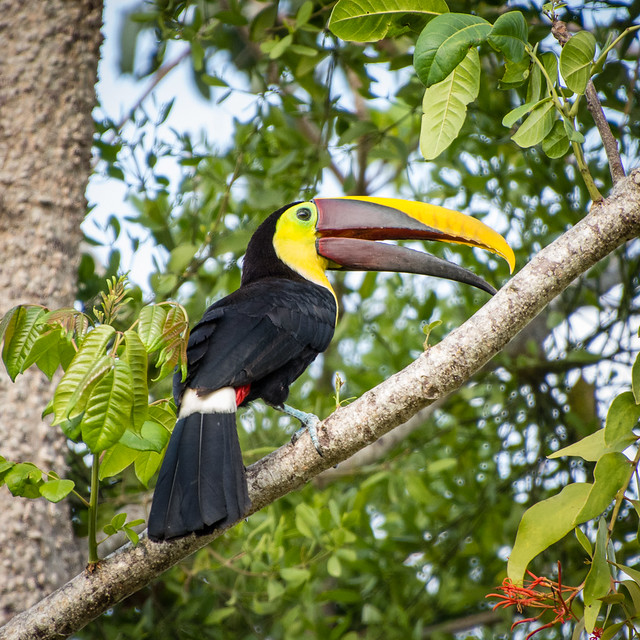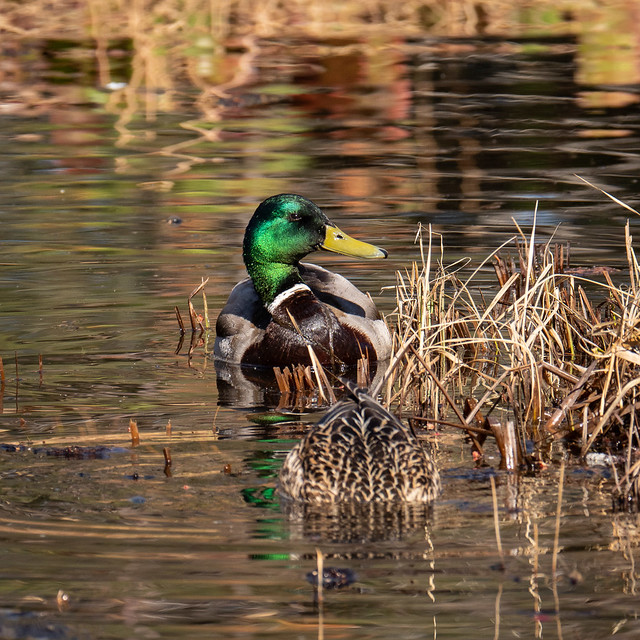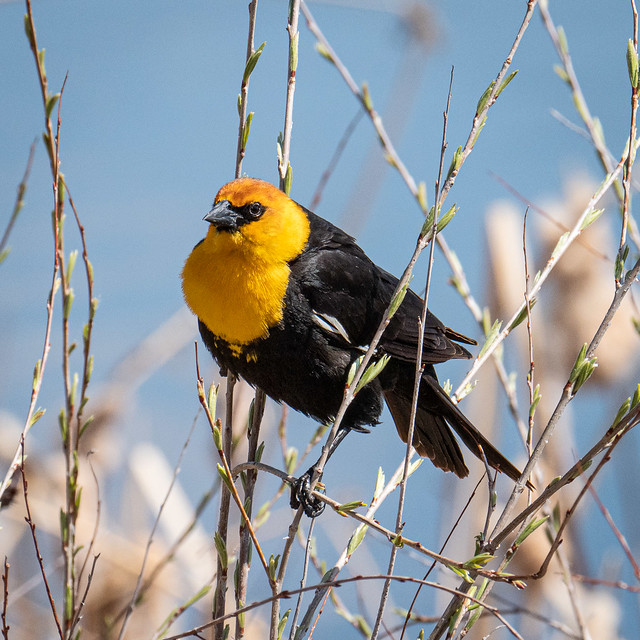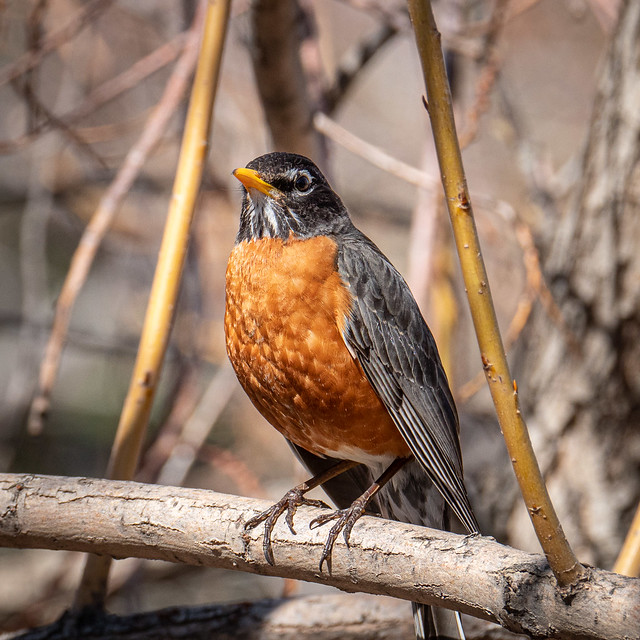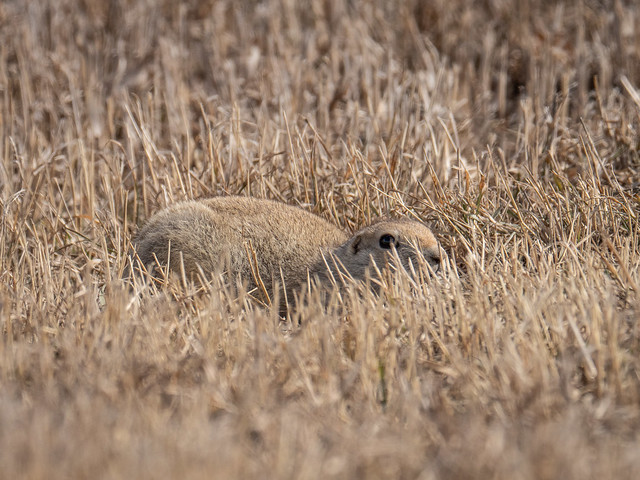Sarah Ludlow is the
Conservation Science/GIS Coordinator for the Nature Conservancy of Canada -Saskatchewan (NCC). Sarah spent a lot of time in nature as a child and was always interested in identifying the wildlife she encountered, but it was an undergraduate class in ornithology that sparked a particular interest in birds. Sarah took a year off from university – but not from birds – after completing her Bachelor’s degrees in Biology and Geography. While working on bird-related fieldwork, Sarah thought, “Wouldn’t it be great if I could do something with all this data?” She headed back to university for a graduate degree researching the impact of oil and gas development on the density and reproductive success of grassland birds.
The fieldwork for her graduate degree involved two summers mapping the habitat, the number of birds, fledgling success rate, and nest survival on Antelope Creek Ranch, Alberta. Sarah and her team stayed on site for the entire season, sharing two RV campers. “There were a lot of really early mornings, getting up before sunrise to map the songbirds we saw and heard,” Sarah says. “Then we moved on to other components of the research.” The team established a 50-metre grid on each 300 x 600-metre study plot, moving slowly through the area, flushing the birds off their nests to count them and then going back to flag and monitor the nests. They also conducted habitat and vegetation surveys, mapping oil and gas infrastructure as well as the presence of crested wheatgrass. The research focused on songbirds – Savannah Sparrow, Vesper Sparrow, Baird’s Sparrow, Western Meadowlark, and Sprague’s Pippit – but Sarah obtained enough data to later analyze and put out a
paper on ducks and shorebirds.
“We found enough nests to have
robust, meaningful results,” Sarah says. The results showed that proximity to wells and roads was not a big factor in determining the birds’ density and reproductive success. However, in areas with a high percentage of
crested wheatgrass, the Sprague’s Pipit nests didn’t do as well and had a lower survival rate.
Areas with large amounts of crested wheatgrass had less plant diversity and fewer insects/arthropods than areas with abundant native grasses. As a result, there was less food available for the chicks and reduced nest survival.
After obtaining her Master’s degree, Sarah spent several years working for the Canadian Wildlife Service with fieldwork in the summer and data analysis and report-writing in the winter. She started working with the Nature Conservancy of Canada in 2015. She ran the volunteer program in her first year, moving on to the GIS position the following year and is now involved in broad-level planning for the Saskatchewan region while continuing the GIS work.
The
Geographic Information System (GIS) provides a framework for presenting data visually and connecting it to a location (species density, for example). One of the first things the NCC does when buying a new property or establishing a conservation easement is to map the area. The map illustrates the conservation value of the property and serves as a baseline for future conservation work on the property.
Over the past few years, the NCC has devoted considerable attention to monitoring grassland songbird and bat populations on their properties. Songbird point counts on the larger grassland properties have been complemented by Sarah’s involvement with
MAPS (Monitoring Avian Productivity and Survivorship) and
BBS (Breeding Bird Survey). The MAPS program monitors breeding birds across Canada and the United States and is administered by the Institute for Bird Populations. It allows scientists to monitor the demographic parameters for species across their entire range and provides a snapshot of the local bird population. The BBS is a continent-wide program that began in the 1960s. It monitors population trends during the peak breeding season each year. Much of the work done to monitor bird populations is carried out by volunteers. “They’re passionate about bird conservation,” Sarah says. “Plus, it’s fun!”
As a science-based organization, the NCC uses the best available science to guide their management practices. However, there is limited data on bat populations in Saskatchewan. “It’s hard to protect habitat for a species if you don’t know what habitat it uses,” Sarah explained. “
We want to find out where bats are roosting and what habitat they use, especially for the endangered myotis bats.” In the first phase of their research, the NCC hired a
bat researcher to carry out
acoustic monitoring. Over the past few years, recorders have been placed near water on over 12 properties. Based on the audio data, they can work out which species are present and their activity level and can then manage the properties to make it easier for the bats. A couple of the properties have shown really high activity levels for
little brown bats. The NCC was also interested to find quite a bit of bat activity on several grassland properties: “There must be a reason they’re making the trip over open grassland to find water,” Sarah says.
The original acoustic monitoring of bats is now being supplemented by additional tracking of little brown and northern myotis bats on NCC’s properties at Nebo and Meeting Lake 3. They’re catching and putting tiny radio transmitters on bats, tracking them to where they roost, and then going back at dusk to count how many bats come out of the roost. NCC is also comparing the trees bats choose to roost in with other nearby trees to work out what the bats are looking for. The tracking has had to be put on hold this year as bat agencies don’t want any handling of bats as they’re concerned that Covid-19 could be transmitted to the bats.
Sarah says that the Nature Conservancy is making other programming changes due to Covid. Volunteer activities have been cancelled and staff will be following strict protocol when carrying out essential fieldwork. Sarah had hoped to band and monitor nestlings found in the nest boxes volunteers have put out over the last couple of years. But that won’t happen as the supply of bands is restricted to what organizations already have in stock. “It will be very collaborative,” Sarah says. “If I don’t need bands of a certain size, I’ll offer them to someone else who does.” Bird banding operations will also need to take precautions to protect both the banders and the birds from Covid-19. Measures will include maintaining physical distancing with people, ensuring only healthy banders handle birds, and extra sanitation of equipment.
Photo Credits
Photos 1 & 2 - Nature Conservancy of Canada
Photo 3 - Joseph Poissant
See Also
Conserving Nature in Saskatchewan: Nature Conservancy of Canada
Prairie Beauty: NCC’s Dundurn Property
You can follow EcoFriendly Sask by liking us on Facebook, following us on Twitter, or by email (top right corner).
